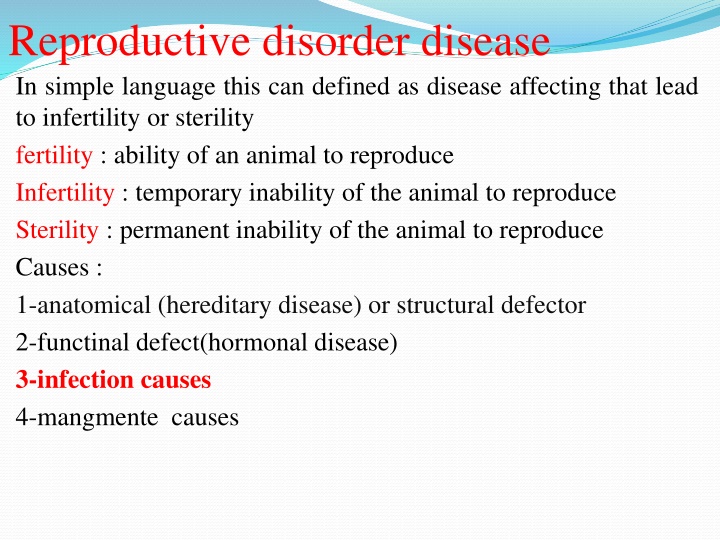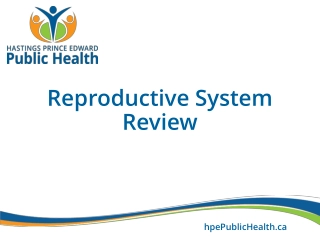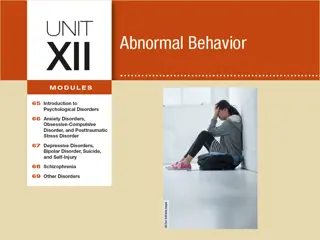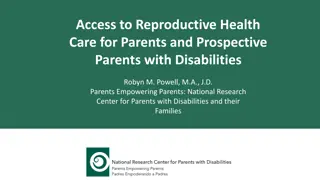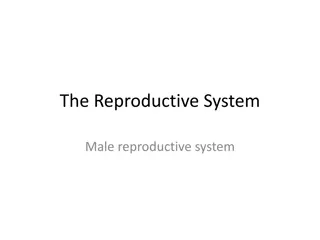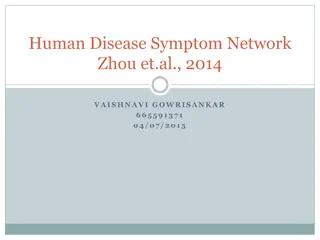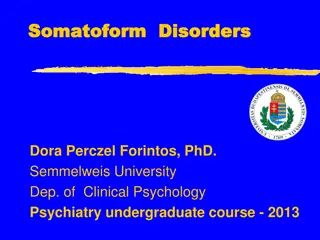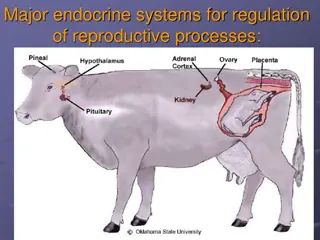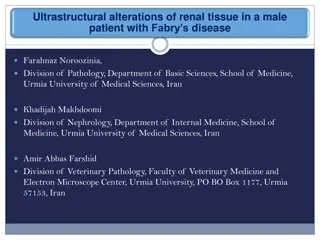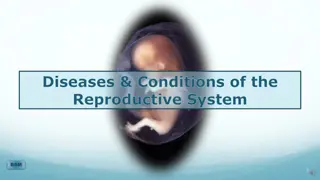Reproductive disorder disease
Reproductive disorders can lead to infertility or sterility in animals due to anatomical, functional, infection, or management causes. Learn about oophoritis, salpingitis, endometritis, and their treatments like antimicrobial and hormonal therapy. Explore the causes, clinical signs, and supportive treatments for these conditions.
Download Presentation

Please find below an Image/Link to download the presentation.
The content on the website is provided AS IS for your information and personal use only. It may not be sold, licensed, or shared on other websites without obtaining consent from the author.If you encounter any issues during the download, it is possible that the publisher has removed the file from their server.
You are allowed to download the files provided on this website for personal or commercial use, subject to the condition that they are used lawfully. All files are the property of their respective owners.
The content on the website is provided AS IS for your information and personal use only. It may not be sold, licensed, or shared on other websites without obtaining consent from the author.
E N D
Presentation Transcript
Reproductive disorder disease In simple language this can defined as disease affecting that lead to infertility or sterility fertility : ability of an animal to reproduce Infertility : temporary inability of the animal to reproduce Sterility : permanent inability of the animal to reproduce Causes : 1-anatomical (hereditary disease) or structural defector 2-functinal defect(hormonal disease) 3-infection causes 4-mangmente causes
Oophoritis / ovaritis Inflammation / infection of ovary Causes : 1- Secondary to trauma 2- infection through uterus 3- extension of infection through uterine walls Treatment : Not easy . Supportive treatment . If infection extended through uterus treatment of the condition
Salpingitis Pyosalpinx in the right and left oviducts Single para-ovarian cyst
Salpigitis Unilateral hydrosalpinx in the right oviduct Bilateral hydrosalpinx
endometritis "Inflammation of endometrium extending not deeper than the stratum spongiosum is called endometritis". Clinical signs : 1- White or whitish-yellow mucopurulent vaginal discharge comes out when a diseased cow sit down. 2- mucopurulent discharge at the time of estrous. 3- No signs of systemic illness like septic puerperal metritis. 4- Repeat breeding and failure of conception are the most common symptoms of endometritis Classification : 1- Clinical endometritis: When the uterine discharge is thrown by the animal, is mucopurulent, it is called clinical endmetritis. 2 - Subclinical endometritis: When the uterine discharge is thrown by the animal is almost clear, but give positive reaction to white side test, this condition is called subclinical endometritis
Treatment: (1) Antimicrobial therapy Oxytetracycline treatment is effective in most of the mixed bacterial infection that exists in the early post-partum uterus. (2) Hormonal therapy: A- Oestradiol valerate - Dose 3 to 10 mg. I/M. This treatment can be repeated at an interval of 7 days if required. B-Oxytocin: Administer low dose (10 to 20 IU) of oxytocin within 4 to 6 hours of the oestrogen injection. C- PGF2a analogues: When corpus luteum is present, PGF2 is the most successful treatment both in terms of cure rate and calving to conception interval. Lutalyse 5 ml. I/M. (3) Supportive therapy Mineral mixture containing Vit. A, D & E helps in regeneration of damaged endometrium and enhances immunity and tone of the uterine muscles
Use metricure to treatment endometritis Use metricure
Pyometra Pyometra is characterized by the accumulation of pus in the uterus and by a retained corpus luteum with failure of estrous". it classified closed pyometra or open pyometra Clinical Signs : 1- In postpartum pyometra, the cervix does not remain too tight. So some of the pus escapes when the cow lies down, urinates or defecates. 2- Fail to show estrous symptoms. 3- per-rectal examination: A- Uterus remains enlarged both the sides. B- Uterine wall is thicker than what it is during pregnancy C- Presence of corpus luteum D- Uterus has more' doughy' (uterus is felt like soft balls of wheat-flour when fingers are pressed into) E- No caruncles
Treatment 1- Oestrogen and Oxytocin therapy: Oestradiol valerate 3-10 mg. intramuscularly followed by Oxytocin 20 IU - 40 IU 24 hours later to sensitize the myometrium and dilate the cervix. 2-The best treatment is the use of PGF2 analogues like lutalyse (5 ml I/M). These cause regression of the corpus luteum, dilatation of the cervix and expulsion of pus within 5-7 days. Evacuation of the uterus is indicated by the signs of estrus. 3- Antimicrobial therapy: antibacterial drug is to be infused into the uterine lumen after expulsion of pus, penicillin is the drug of choice because after 25 to 30 days postpartum only c.pyogenes and Gram- negative anaerobes remain in the uterus of most of the cows with metritis or pyometra. 4- lugal s iodine 0.5% intra uterine therapy :(0.5gram iodine +1grame potasium iodine complete to 100ml distal waters ) use 100- 500ml according to size of uterus.
Pyometra pregnancy 1- anestrous 2- persist corpus luteum 3- cervix closed or open 4- Uterine wall is thicker 5- Uterus has more' doughy 6- symmetric uterine horn 7- found pus in the uterus 1- anestrous 2- found CL 3- the cervix closed 4- Uterine wall is thin wall 5- slipping of fetal membrane 6- asymmetric uterine horn 7- found fetus and caruncles in uterus 8- thrilling of middle uterine artery 8- prevent give prostaglandin because leads to abortion 8- no thrilling of middle uterine artery 8- treatment by prostaglandin
Cervicitis definition Inflammation of cervix is associated with metritis following abnormal parturition contamination. Symptoms : external os is edematous , swollen , prolapsed external fold . Reddish mucopuruleant cervical mucosa Treatment : 1- Painting with lugal s iodine 3- Uterine douche through vaginal
Vaginitis Definition :often secondary to metritis or cervictis . Also as result of trauma and laceration . Causes : 1- non spesific infection like corynebacterium. 2- specific causes like IBR, trichomonasis and vibriosis Symptoms : Mucopurulant yellow grey pus is discharged through vulva at irregular interval . On vaginal examination exudate is noticed on the vaginal floor , vaginal wall is inflamed , congest and edematous. Treatment : 1- Flashing of vagina with mild antiseptics 2-Antibiotic infusion strep.cocci , staph.cocci ,
Granular vulvo - vagintis It is an infection disease of vulva and vagina characterized by :development of small elevated pustules or granules . The lesions are more common on the vulva than in vagina . In acute cases the pustules are highly inflamed causing a mucopurulent discharge , which may hang , or mat the hair coat around the tail. Treatment 1- flushing with antiseptics . 2- antibiotics including local application
Abortion Infectious Causes: *Especially if abortion storm! Protozoal Trichomonas Neospora Viral IBR BVD Mycotic Bacterial Brucella spp Listeriosis Leptospirosis Arcanobacterium pyogenes Vibriosis
